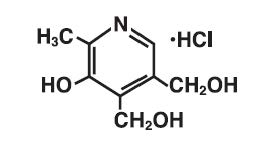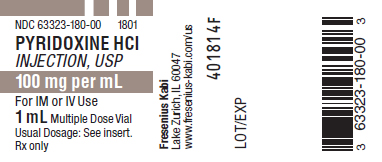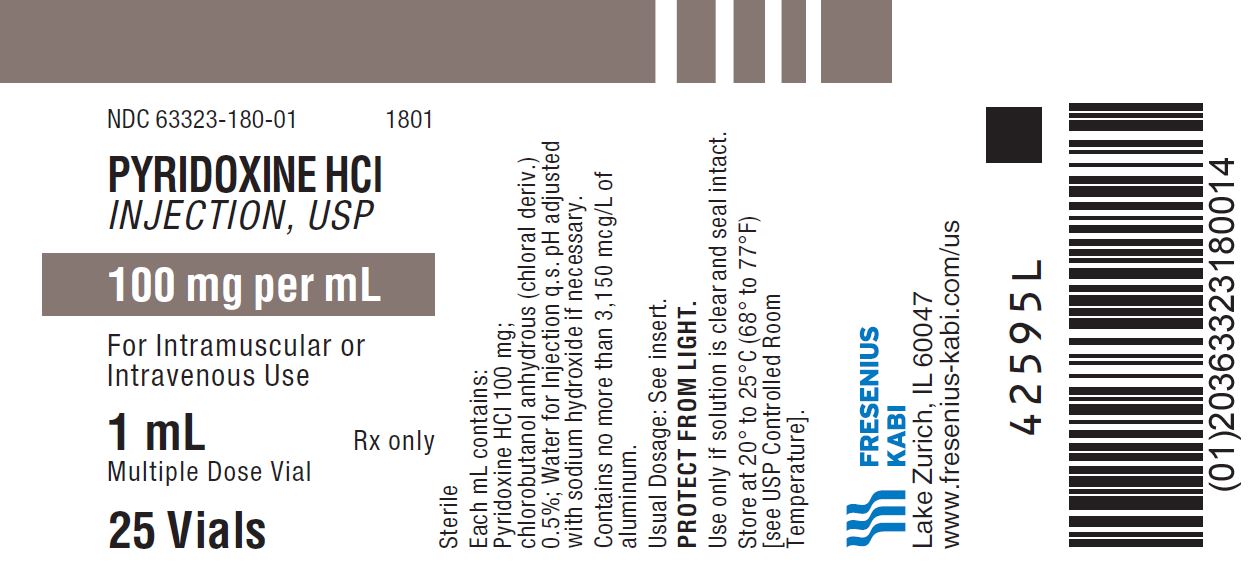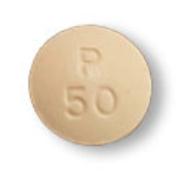Pyridoxine Hydrochloride Injection: Package Insert / Prescribing Info
Package insert / product label
Dosage form: injection, solution
Drug class: Vitamins
J Code (medical billing code): J3415 (100 mg, injection)
Medically reviewed by Drugs.com. Last updated on Oct 22, 2024.
On This Page
Pyridoxine Hydrochloride Injection Description
Pyridoxine Hydrochloride Injection, USP is a sterile solution of pyridoxine hydrochloride in Water for Injection. Each mL contains 100 mg pyridoxine hydrochloride and 0.5% chlorobutanol anhydrous (chloral deriv.). pH adjusted with sodium hydroxide if necessary (2.0 to 3.8).
Pyridoxine hydrochloride is a colorless or white crystal or a white crystalline powder. One gram dissolves in 5 mL of water. It is stable in air and is slowly affected by sunlight.
The chemical name is 2-methyl-3-hydroxy-4,5-bis (hydroxymethyl) pyridine hydrochloride.
The structural formula is:
Pyridoxine Hydrochloride Injection - Clinical Pharmacology
Natural substances that have vitamin B 6 activity are pyridoxine in plants and pyridoxal or pyridoxamine in animals. All 3 are converted to pyridoxal phosphate by the enzyme pyridoxal kinase. The physiologically active forms of vitamin B 6 are pyridoxal phosphate (codecarboxylase) and pyridoxamine phosphate. Riboflavin is required for the conversion of pyridoxine phosphate to pyridoxal phosphate.
Vitamin B 6 acts as a coenzyme in the metabolism of protein, carbohydrate, and fat. In protein metabolism, it participates in the decarboxylation of amino acids, conversion of tryptophan to niacin or to serotonin (5-hydroxtryptamine), deamination, and transamination and transulfuration of amino acids. In carbohydrate metabolism, it is responsible for the breakdown of glycogen to glucose-1-phosphate.
The total adult body pool consists of 16 to 25 mg of pyridoxine. Its half-life appears to be 15 to 20 days. Vitamin B 6 is degraded to 4-pyridoxic acid in the liver. This metabolite is excreted in the urine.
The need for pyridoxine increases with the amount of protein in the diet. The tryptophan load test appears to uncover early vitamin B 6 deficiency by detecting xanthinurea. The average adult minimum daily requirement is about 1.25 mg. The ‘‘Recommended Dietary Allowance’’ of the National Academy of Sciences is estimated to be as much as 2.2 mg for adults and 2.5 mg for pregnant and lactating women. The requirements are more in persons having certain genetic defects or those being treated with isonicotinic acid hydrazide (INHJ) or oral contraceptives.
Indications and Usage for Pyridoxine Hydrochloride Injection
Pyridoxine Hydrochloride Injection is effective for the treatment of pyridoxine deficiency as seen in the following:
Inadequate dietary intake.
Drug-induced deficiency, as from isoniazid (INH) or oral contraceptives.
Inborn errors of metabolism, e.g., vitamin B 6 dependent convulsions or vitamin B 6 responsive anemia.
The parenteral route is indicated when oral administration is not feasible as in anorexia, nausea and vomiting, and preoperative and postoperative conditions. It is also indicated when gastrointestinal absorption is impaired.
Contraindications
A history of sensitivity to pyridoxine or to any of the ingredients in Pyridoxine Hydrochloride Injection, USP is a contraindication.
Warnings
WARNING: This product contains aluminum that may be toxic. Aluminum may reach toxic levels with prolonged parenteral administration if kidney function is impaired. Premature neonates are particularly at risk because their kidneys are immature, and they require large amounts of calcium and phosphate solutions, which contain aluminum.
Research indicates that patients with impaired kidney function, including premature neonates, who receive parenteral levels of aluminum at greater than 4 to 5 mcg/kg/day accumulate aluminum at levels associated with central nervous system and bone toxicity. Tissue loading may occur at even lower rates of administration.
Precautions
General
Single deficiency, as of pyridoxine alone, is rare. Multiple vitamin deficiency is to be expected in any inadequate diet. Patients treated with levodopa should avoid supplemental vitamins that contain more than 5 mg pyridoxine in the daily dose.
Women taking oral contraceptives may exhibit increased pyridoxine requirements.
Drug Interactions
Pyridoxine supplements should not be given to patients receiving levodopa, because the action of the latter drug is antagonized by pyridoxine. However, this vitamin may be used concurrently in patients receiving a preparation containing both carbidopa and levodopa.
Pregnancy
Pregnancy Category A—The requirement for pyridoxine appears to be increased during pregnancy. Pyridoxine is sometimes of value in the treatment of nausea and vomiting of pregnancy.
Adverse Reactions/Side Effects
To report SUSPECTED ADVERSE REACTIONS, contact Fresenius Kabi USA, LLC at 1-800-551-7176 or FDA at 1-800-FDA-1088 or www.fda.gov/medwatch.
Paresthesia, somnolence, and low serum folic acid levels have been reported.
Drug Abuse and Dependence
Symptoms of dependence have been noted in adults given only 200 mg daily, followed by withdrawal.
Overdosage
Pyridoxine given to animals in amounts of 3 to 4 g/kg of body weight produces convulsions and death. In man, a dose of 25 mg/kg of body weight is well tolerated.
Pyridoxine Hydrochloride Injection Dosage and Administration
Pyridoxine Hydrochloride Injection may be administered intramuscularly or intravenously. In cases of dietary deficiency, the dosage is 10 to 20 mg daily for 3 weeks. Follow-up treatment is recommended daily for several weeks with an oral therapeutic multivitamin preparation containing 2 to 5 mg pyridoxine. Poor dietary habits should be corrected, and an adequate, well balanced diet should be prescribed.
The vitamin B 6 dependency syndrome may require a therapeutic dosage of as much as 600 mg a day and a daily intake of 30 mg for life.
In deficiencies due to INH, the dosage is 100 mg daily for 3 weeks followed by a 30 mg maintenance dose daily.
In poisoning caused by ingestion of more than 10 g of INH, an equal amount of pyridoxine should be given — 4 g intravenously followed by 1 g intramuscularly every 30 minutes.
Parenteral drug products should be inspected visually for particulate matter and discoloration prior to administration, whenever solution and container permit.
How is Pyridoxine Hydrochloride Injection supplied
Pyridoxine Hydrochloride Injection, USP is supplied as:
| Product Code | Unit of Sale
| Strength | Each |
| 1801
| NDC 63323-180-01
Unit of 25 | 100 mg per mL
| NDC 63323-180-00
1 mL fill, in a 2 mL multiple dose vial |
PROTECT FROM LIGHT.
Use only if solution is clear and seal intact.
Sterile.
Store at 20° to 25°C (68° to 77°F) [see USP Controlled Room Temperature].
| PYRIDOXINE HYDROCHLORIDE
pyridoxine hydrochloride injection, solution |
||||||||||||||||||||
|
||||||||||||||||||||
|
||||||||||||||||||||
|
||||||||||||||||||||
|
||||||||||||||||||||
|
||||||||||||||||||||
| Labeler - Fresenius Kabi USA, LLC (608775388) |
| Establishment | |||
| Name | Address | ID/FEI | Business Operations |
|---|---|---|---|
| Fresenius Kabi USA, LLC | 840771732 | manufacture(63323-180) | |
More about pyridoxine
- Check interactions
- Compare alternatives
- Pricing & coupons
- Reviews (4)
- Drug images
- Side effects
- Dosage information
- During pregnancy
- Drug class: vitamins
- En español





